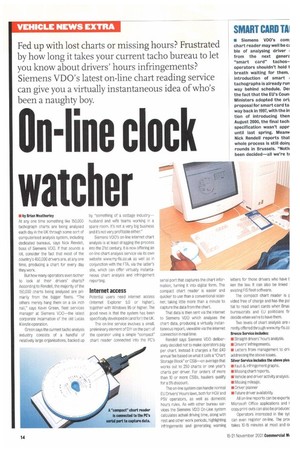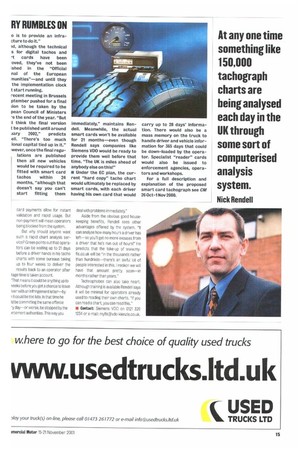n-line clock watcher
Page 14

Page 15

If you've noticed an error in this article please click here to report it so we can fix it.
• by Brian Weathorley At any one time something like 150,000 tachograph charts are being analysed each day in the UK through some sort of computerised analysis system, including dedicated bureaus, says Nick Rendell, boss of Siemens VDO. If that sounds a lot, consider the fact that most of the country's 450,000 drivers are, at any one time, producing a chart for every day they work.
But how many operators even bother to look at their drivers' charts? According to Rendell, the majority of the 150,000 charts being analysed are primarily from the bigger fleets. "The others merely hang them on a six inch nail," says Kevin Green, fleet services manager at Siemens VDO—the latest corporate incarnation of the old Lucas Kienzle operation.
Green says the current tacho analysis industry consists of a handful of relatively large organisations, backed up by "something of a cottage industry— husband and wife teams working in a spare room. It's not a very big business and it's not very profitable either."
Siemens VDO's on-line internet chart analysis is at least dragging the process into the 21st century. It is now offering an on-line chart analysis service via its own vvebsite www.my-fis.co.uk as well as in conjunction with the ETA, via the latter's site, which can offer virtually instantaneous chart analysis and infringement reporting.
Internet access
Potentlal users need Internet access (Internet Explorer 5.0 or higher), together with Windows 95 or higher. The good news is that the system has been specifically developed in and for) the UK.
The on-line service involves a small, preliminary element of DIY on the part of the operator using a simple "compact" chart reader connected into the PC's serial port that captures the chart information, turning it into digital form. The compact chart reader is easier and quicker to use than a conventional scanner, taking little more than a minute to capture the data from the chart.
That data is then sent via the internet to Siemens VDO which analyses the chart data, producing a virtually instantaneous report, viewable via the internet connection in real time.
Bendel' says Siemens VDO deliberately decided not to make operators pay per chart. Instead Et charges a flat ,240 annual fee based on what it calls a "Chart Storage Block" or CSB—on average that works out to 250 charts or one year's charts per driver. For orders of more than 10 or more CSBs, hauliers qualify for a 5% discount.
The on-line system can handle normal EU Drivers' Hours laws, both for HGV and PSV operators, as well as domestic hours rules. As with other bureau services the Siemens VDO On-Line system calculates actual driving time, along with rest and other work periods, highlighting infringements and generating warning letters for those drivers who have t ken the law. It can also be linked existing FIS fleet software.
The compact chart reader is r vided free of charge and has the poi tial to read smart cards when Brusi bureaucrats and EU politicians fir decide when we're to have them.
Two levels of chart analysis are rently offered through www.my-fis.cc Bronze Service includes: • Straight drivers' hours analysis.
• Drivers' infringements.
• Letters from management to dri \ addressing the above issues. Silver Service Includes the above plus
• Fault 86 infringement graphs.
• Missing chart reports.
• Vehicle and driver activity analysis.
• Missing mileage, • Driver planner • Future driver availability.
All on-line reports can be exporte Microsoft Office applications and copy print-outs can also be producer Operators interested in the sys can even register on-line. The pro( takes 10-15 minutes at most and ci card payments allow for instant validation and rapid usage. But non-payment will mean operators being blocked from the system.
But why should anyone want such a rapid chart analysis service? Green points out that operators can be waiting up to 21 days before a driver hands in his tacho charts with some bureaus taking up to four weeks to deliver the results back to an operator after tage time is taken account.
'That means it could be anything up to veeks before you get a chance to issue iver with an infringement letter—by it could be too late. In that time he Id be committing the same offence -y day—or worse, be stopped by the arcement authorities. This way you
deal with problems immediately."
Aside from the obvious good housekeeping benefits, Rendell sees other advantages offered by the system. "It can analyse how many hours a driver has left—so you'll get no more excuses from a driver that he's run out of hours!" He predicts that the take-up of www.myfis.co.uk will be in the thousands rather than hundreds—there's an awful lot of people interested in this. I reckon we will have that amount pretty soon—in months rather than years."
Technophobes can also take heart Although training is available Rendell says it will be minimal for operators already used to reading their own charts. "If you can read a chart, you can read this."
• Contact: Siemens VDD on 0121 326 1234 or e-mail: myfis®vdo-kienzle.co.uk.




























































































































































